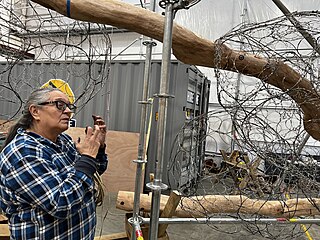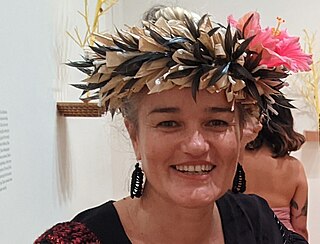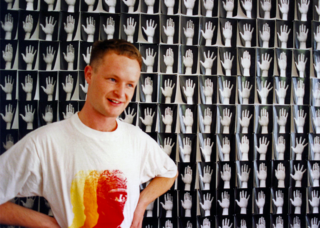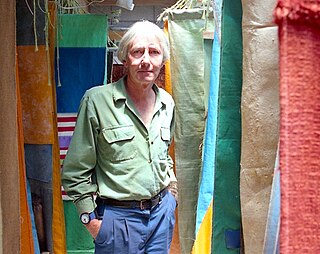Public sculptures
Tohi has a number of sculptures in public or semi-public places.
Ha’amonga mata’a Maui, 1996
Museum of New Zealand Te Papa Tongarewa, Wellington, New Zealand.
This sculpture, made of andesite stone and 174 cm high, is placed in the exhibition Tangata o le Moana: the story of Pacific people in New Zealand. [10]
Te Papa's label for this sculpture explains that it depicts the eye of the demigod Maui in a stone surround, and that the form is based on that of the ancient stone monuments found in Tonga. A loose translation of the title is "the vision of Maui". [22] An example of a massive ancient Tongan stone monument is Ha'amonga 'a Maui.
Haupapa (Female), 1998
Govett-Brewster Gallery, New Plymouth, New Zealand
Untitled, 2000, installed 2006

The Square, Palmerston North, New Zealand
This work is one of ten andesite sculptures carved as part of a project for the Pacific Rim Millennium Experience (PRiME). [23]
Pacific Room, 2002
Inside the New Zealand Parliament, the entrance to The Pacific Room is designed by Ian George, and the wooden carving was carved by four carvers from the South Pacific, Ian George from Cook Islands, Fatu Feu'u from Samoa, Filipe Tohi from Tonga, and Palalagi Manetoa from Niue, about how Pacific peoples from those islands came to New Zealand and made the new country home.
Halamoana (Ocean Pathway), 2003
Corner of Brougham and Powderham Streets, New Plymouth.
This 14-metre-high (46 ft) aluminium sculpture was commissioned by New Plymouth architect Terry Boon, who also donated the land it stands on. [24] [25] Boon said that this work expressed the lalava philosophy and that in it Tohi was "decoding language and symbols from the Pacific". [26] In the same article, Boon is quoted on the significance of the site: "Brougham street is historically important...; it runs down the slope to the spot on the foreshore where Maori and European settlers landed. The street terminates across the road from the Len Lye Wind Wand."
Hautaha (Coming Together), 2004

Outside the public library, Onehunga, Auckland.
This large sculpture made of stacked steel tubes is about the coming together of diverse groups, including early Maori, European colonists and more recent migrants from Pacific Islands. It also suggests the ropework on their boats. Tohi said that he "sees the form as female, embracing, welcoming and encompassing local residents and visitors to the community." [27] [28]
Matakimoana (Eye of the Ocean), 2007
Museum of New Zealand Te Papa Tongarewa, Wellington, New Zealand.
This large aluminium sculpture is at the entrance to the exhibition Tangata o le Moana: the story of Pacific people in New Zealand. [29]
In a film accompanying this sculpture, Tohi explains that it reflects the importance of lalava technology in Tonga. [30] Before industrial technology became common in Tonga, lalava was used in making fale (buildings), fishhooks and other tools. In such uses, the cords are usually wrapped around cylindrical forms, such as the poles supporting a building. Tohi explains how he has brought out the patterns that were inside the wrapping, to make them visible.
Poutaha, 2014

Welded Aluminium. Massey University, Wellington campus, near Entrance A.
Massey University's information pamphlet on this sculpture says that its title means "a marker, like those of a memorial or kumara god", and that ancient godsticks "marked boundaries when wrapped with rope". The pamphlet includes a diagram of several stages in the lashing of the lower, tapered cylinder part, of a god stick. [31]
Vaka Folau (Canoes for the Journey), 2014
Extruded aluminium, Victoria University of Wellington, Kelburn campus, library, second floor.
This large sculpture takes the form of a gateway into Wan Solwara, the Pasifika area of the Victoria University Library in Kelburn. Its wall label explains that it is based on three triangles, representing Melanesia, Micronesia and Polynesia. Small wave-like triangular forms represent the ocean that binds these cultural entities together. The upright sides of the gateway suggest two canoes.
Te Auaunga Awa – Multicultural Fāle and Outdoor Classroom, 2019
Steel and wood, Walmsley Park, Mount Roskill, Auckland.
A functional meeting space based on a traditional fāle incorporating lalava forms, commissioned by Auckland Council. [32] It won the Small Project Architecture category at the 2020 NZIA Auckland Architecture Awards. [33]











